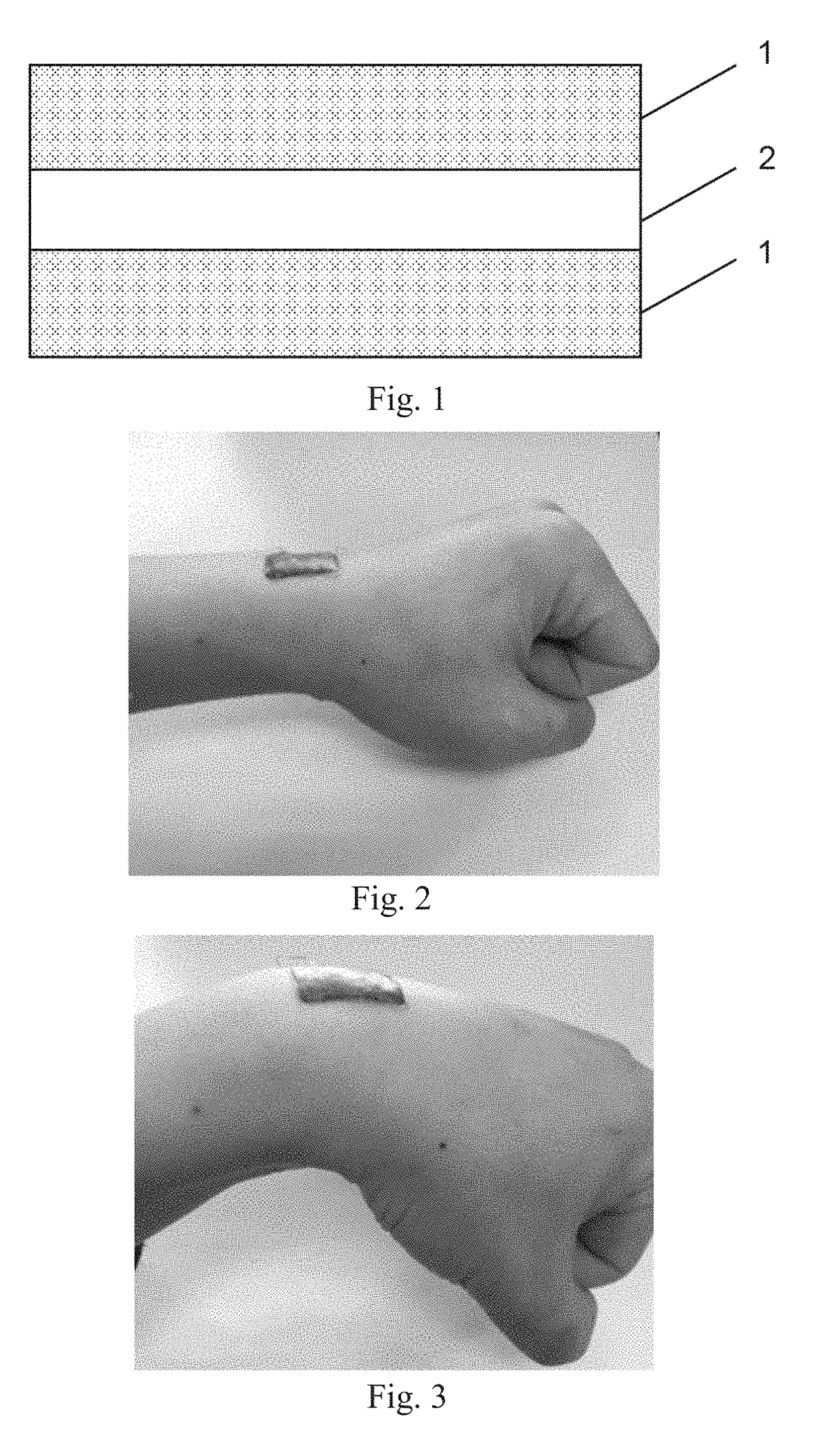Three-layer self-healing flexible strain sensor and preparation method thereof
a self-healing, flexible strain sensor technology, applied in the field of functional films, can solve the problems of reducing the performance of materials and devices, difficult to discover or detect, and inability to cure defects or damage on the interior or surface of materials, so as to improve the repair effect, and quickly repair internal and external damage
- Summary
- Abstract
- Description
- Claims
- Application Information
AI Technical Summary
Benefits of technology
Problems solved by technology
Method used
Image
Examples
embodiment 1
[0063]The present invention uses the doped carbon material to form the self-healing sensitive layer, and a preparation method of the three-layer self-healing flexible strain sensor comprises specific steps of:
[0064]S1: adding 40 ml tetrahydrofuran into a first reaction flask, then adding 0.8 g polyacrylic acid (PAA), 70 mg N,N′-dicyclohexylcarbodiimide (DCC) and 55 mg 4-(dimethyl)aminopyridine (DMAP) in sequence; putting a magnetic stir bar into the first reaction flask and placing the first reaction flask on a magnetic stirrer to stir with 400-500 r / min for 2 h; adding 0.2 g hydroxy-terminated polydimethylsiloxane (PDMS) into the first reaction flask, sealing and magnetically stirring at the room temperature for 12 h; and heating the solution to 90° C., then stirring for 20 min for evaporating a solvent till the solution is concentrated, so as to obtain the concentrated solution;
[0065]S2: adding 40 ml tetrahydrofuran into a second reaction flask, then adding 0.8 g polyacrylic acid ...
embodiment 2
[0071]The present invention uses the conductive composite to form the self-healing sensitive layer, and a preparation method of the three-layer self-healing flexible strain sensor comprises specific steps of:
[0072]S1: adding 40 ml tetrahydrofuran into a first reaction flask, then adding 1 g polyacrylic acid (PAA), 86 mg N,N′-dicyclohexylcarbodiimide (DCC) and 60 mg 4-(dimethyl)aminopyridine (DMAP) in sequence; putting a magnetic stir bar into the first reaction flask and placing the first reaction flask on a magnetic stirrer to stir with 400-500 r / min for 2 h; adding 0.2 g hydroxy-terminated polydimethylsiloxane (PDMS) into the first reaction flask, sealing and magnetically stirring at the room temperature for 12 h; and heating the solution to 90° C., then stirring for 20 min for evaporating a solvent till the solution is concentrated, so as to obtain the concentrated solution;
[0073]S2: adding 40 ml tetrahydrofuran into a second reaction flask, then adding 0.8 g polyacrylic acid (PA...
embodiment 3
[0079]The present invention uses the conductive composite to form the self-healing sensitive layer, and a preparation method of the three-layer self-healing flexible strain sensor comprises specific steps of:
[0080]S1: adding 40 ml tetrahydrofuran into a first reaction flask, then adding 1 g polyacrylic acid (PAA), 86 mg N,N′-dicyclohexylcarbodiimide (DCC) and 50 mg 4-(dimethyl)aminopyridine (DMAP) in sequence; putting a magnetic stir bar into the first reaction flask and placing the first reaction flask on a magnetic stirrer to stir with 400-500 r / min for 2 h; adding 0.25 g hydroxy-terminated polydimethylsiloxane (PDMS) into the first reaction flask, sealing and magnetically stirring at the room temperature for 12 h; and heating the solution to 90° C., then stirring for 20 min for evaporating a solvent till the solution is concentrated, so as to obtain the concentrated solution;
[0081]S2: adding 40 ml tetrahydrofuran into a second reaction flask, then adding 1 g polyacrylic acid (PAA...
PUM
| Property | Measurement | Unit |
|---|---|---|
| weight | aaaaa | aaaaa |
| conductive | aaaaa | aaaaa |
| temperature | aaaaa | aaaaa |
Abstract
Description
Claims
Application Information
 Login to View More
Login to View More - R&D
- Intellectual Property
- Life Sciences
- Materials
- Tech Scout
- Unparalleled Data Quality
- Higher Quality Content
- 60% Fewer Hallucinations
Browse by: Latest US Patents, China's latest patents, Technical Efficacy Thesaurus, Application Domain, Technology Topic, Popular Technical Reports.
© 2025 PatSnap. All rights reserved.Legal|Privacy policy|Modern Slavery Act Transparency Statement|Sitemap|About US| Contact US: help@patsnap.com


